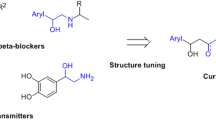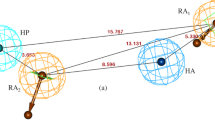Abstract
Structure-based drug design (SBDD) is an important in silico technique, used for the identification of enzyme inhibitors. Acetylcholinesterase (AChE), obtained from Electrophorus electricus (ee), is widely used for the screening of AChE inhibitors. It shares structural homology with the AChE of human and other organisms. Till date, the three-dimensional crystal structure of enzyme from ee is not available that makes it challenging to use the SBDD approach for the identification of inhibitors. A homology model was developed for eeAChE in the present study, followed by its structural refinement through energy minimisation. The docking protocol was developed using a grid dimension of 84 × 66 × 72 and grid point spacing of 0.375 Å for eeAChE. The protocol was validated by redocking a set of co-crystallised inhibitors obtained from mouse AChE, and their interaction profiles were compared. The results indicated a poor performance of the Autodock scoring function. Hence, a batch of machine learning-based scoring functions were developed. The validation results displayed an accuracy of 81.68 ± 1.73% and 82.92 ± 3.05% for binary and multiclass classification scoring function, respectively. The regression-based scoring function produced \(r^{2} ,\;Q^{2}_{f1}\) and \(Q^{2}_{f2}\) values of 0.94, 0.635 and 0.634, respectively.
Graphic abstract











Similar content being viewed by others
References
Zhou Y, Wang S, Zhang Y (2010) Catalytic reaction mechanism of acetylcholinesterase determined by Born–Oppenheimer ab initio QM/MM molecular dynamics simulations. J Phys Chem B 114(26):8817–8825. https://doi.org/10.1021/jp104258d
Ariel N, Ordentlich A, Barak D, Bino T, Velan B, Shafferman A (1998) The “aromatic patch” of three proximal residues in the human acetylcholinesterase active centre allows for versatile interaction modes with inhibitors. Biochem J 335(1):95–102. https://doi.org/10.1042/bj3350095
Ordentlich A, Barak D, Kronman C, Flashner Y, Leitner M, Segall Y et al (1993) Dissection of the human acetylcholinesterase active center determinants of substrate specificity. Identification of residues constituting the anionic site, the hydrophobic site, and the acyl pocket. J Biol Chem 268(23):17083–17095. https://doi.org/10.1016/S0021-9258(19)85305-X
Sussman JL, Harel M, Frolow F, Oefner C, Goldman A, Toker L et al (1991) Atomic structure of acetylcholinesterase from Torpedo californica: a prototypic acetylcholine-binding protein. Science (New York, NY) 253(5022):872–879. https://doi.org/10.1126/science.1678899
Dvir H, Silman I, Harel M, Rosenberry TL, Sussman JL (2010) Acetylcholinesterase: from 3D structure to function. Chem Biol Interact 187(1–3):10–22. https://doi.org/10.1016/j.cbi.2010.01.042
Chubb I, Ranieri E, Hodgson A, White G (1982) The hydrolysis of Leu-and Met-enkephalin by acetylcholinesterase. Neurosci Lett (Suppl) 8:S39
Chubb I, Hodgson A, White G (1980) Acetylcholinesterase hydrolyzes substance P. Neuroscience 5(12):2065–2072. https://doi.org/10.1016/0306-4522(80)90124-4
Lamers WH, Korstschot AT, Los JA, Moorman AF (1987) Acetylcholinesterase in prenatal rat heart: a marker for the early development of the cardiac conductive tissue? Anat Rec 217(4):361–370. https://doi.org/10.1002/ar.1092170407
Nakamura T, Ikeda T, Shimokawa I, Inoue Y, Suematsu T, Sakai H et al (1994) Distribution of acetylcholinesterase activity in the rat embryonic heart with reference to HNK-1 immunoreactivity in the conduction tissue. Anat Embryol 190(4):367–373. https://doi.org/10.1007/BF00187294
Vigny M, Grassi J, Massoulié J, Lazar M (1980) Globular forms of acetylcholinesterase in caudate nucleus superior cervical ganglia and neuroblastoma cells: interaction with detergents. In: Brzin M, Sket D, Bachelard H (eds) Synaptic constituents in health and disease. Pergamon Press Ltd., Oxford, pp 530–532. https://doi.org/10.1016/B978-0-08-025921-5.50194-6
Ibach B, Haen E (2004) Acetylcholinesterase inhibition in Alzheimer’s disease. Curr Pharm Des 10(3):231–251. https://doi.org/10.2174/1381612043386509
Kumar D, Gupta SK, Ganeshpurkar A, Gutti G, Krishnamurthy S, Modi G et al (2018) Development of Piperazinediones as dual inhibitor for treatment of Alzheimer’s disease. Eur J Med Chem 150:87–101. https://doi.org/10.1016/j.ejmech.2018.02.078
Swetha R, Kumar D, Gupta SK, Ganeshpurkar A, Singh R, Gutti G et al (2019) Multifunctional hybrid sulfonamides as novel therapeutic agents for Alzheimer’s disease. Future Med Chem 11(24):3161–3178. https://doi.org/10.4155/fmc-2019-0106
Gutti G, Kakarla R, Kumar D, Beohar M, Ganeshpurkar A, Kumar A et al (2019) Discovery of novel series of 2-substituted benzo[d]oxazol-5-amine derivatives as multi-target directed ligands for the treatment of Alzheimer’s disease. Eur J Med Chem 182:111613. https://doi.org/10.1016/j.ejmech.2019.111613
Ganeshpurkar A, Swetha R, Kumar D, Gangaram GP, Singh R, Gutti G et al (2019) Protein–protein interactions and aggregation inhibitors in Alzheimer’s disease. Curr Top Med Chem 19(7):501–533. https://doi.org/10.2174/1568026619666190304153353
Mehndiratta MM, Pandey S, Kuntzer T (2014) Acetylcholinesterase inhibitor treatment for myasthenia gravis. Cochrane Database Syst Rev. https://doi.org/10.1002/14651858.CD006986.pub3
Almasieh M, MacIntyre JN, Pouliot M, Casanova C, Vaucher E, Kelly ME et al (2013) Acetylcholinesterase inhibition promotes retinal vasoprotection and increases ocular blood flow in experimental glaucoma. Invest Ophthalmol Vis Sci 54(5):3171–3183. https://doi.org/10.1167/iovs.12-11481
Batool M, Ahmad B, Choi S (2019) A structure-based drug discovery paradigm. Int J Mol Sci 20(11):2783. https://doi.org/10.3390/ijms20112783
Wang X, Song K, Li L, Chen L (2018) Structure-based drug design strategies and challenges. Curr Top Med Chem 18(12):998–1006. https://doi.org/10.2174/1568026618666180813152921
Sándor M, Kiss R, Keserű GM (2010) Virtual fragment docking by glide: a validation study on 190 protein−fragment complexes. J Chem Inf Model 50(6):1165–1172. https://doi.org/10.1021/ci1000407
Hevener KE, Zhao W, Ball DM, Babaoglu K, Qi J, White SW et al (2009) Validation of molecular docking programs for virtual screening against dihydropteroate synthase. J Chem Inf Model 49(2):444–460. https://doi.org/10.1021/ci800293n
Taha MO, Habash M, Khanfar MA (2014) The use of docking-based comparative intermolecular contacts analysis to identify optimal docking conditions within glucokinase and to discover of new GK activators. J Comput-Aided Mol Des 28(5):509–547. https://doi.org/10.1007/s10822-014-9740-4
Kinnings SL, Liu N, Tonge PJ, Jackson RM, Xie L, Bourne PE (2011) A machine learning-based method to improve docking scoring functions and its application to drug repurposing. J Chem Inf Model 51(2):408–419. https://doi.org/10.1021/ci100369f
Zhang L, Ai H-X, Li S-M, Qi M-Y, Zhao J, Zhao Q et al (2017) Virtual screening approach to identifying influenza virus neuraminidase inhibitors using molecular docking combined with machine-learning-based scoring function. Oncotarget 8(47):83142. https://doi.org/10.18632/oncotarget.20915
Ballester PJ, Mitchell JB (2010) A machine learning approach to predicting protein–ligand binding affinity with applications to molecular docking. Bioinformatics 26(9):1169–1175. https://doi.org/10.1093/bioinformatics/btq112
Khamis MA, Gomaa W (2015) Comparative assessment of machine-learning scoring functions on PDBbind 2013. Eng Appl Artif Intell 45:136–151. https://doi.org/10.1016/j.engappai.2015.06.021
Altschul SF, Gish W, Miller W, Myers EW, Lipman DJ (1990) Basic local alignment search tool. J Mol Biol 215(3):403–410. https://doi.org/10.1016/s0022-2836(05)80360-2
Camacho C, Coulouris G, Avagyan V, Ma N, Papadopoulos J, Bealer K et al (2009) BLAST+: architecture and applications. BMC Bioinform 10:421. https://doi.org/10.1186/1471-2105-10-421
Ganeshpurkar A, Kumar D, Singh SK (2018) Design, synthesis and collagenase inhibitory activity of some novel phenylglycine derivatives as metalloproteinase inhibitors. Int J Biol Macromol 107:1491–1500. https://doi.org/10.1016/j.ijbiomac.2017.10.008
Xu Y, Wang S, Hu Q, Gao S, Ma X, Zhang W et al (2018) CavityPlus: a web server for protein cavity detection with pharmacophore modelling, allosteric site identification and covalent ligand binding ability prediction. Nucleic Acids Res 46(W1):W374–W379. https://doi.org/10.1093/nar/gky380
Biasini M, Bienert S, Waterhouse A, Arnold K, Studer G, Schmidt T et al (2014) SWISS-MODEL: modelling protein tertiary and quaternary structure using evolutionary information. Nucleic Acids Res 42(W1):W252–W258. https://doi.org/10.1093/nar/gku340
Consortium U (2019) UniProt: a worldwide hub of protein knowledge. Nucleic Acids Res 47(D1):D506–D515. https://doi.org/10.1093/nar/gky1049
Benkert P, Biasini M, Schwede T (2011) Toward the estimation of the absolute quality of individual protein structure models. Bioinformatics 27(3):343–350. https://doi.org/10.1093/bioinformatics/btq662
Williams CJ, Headd JJ, Moriarty NW, Prisant MG, Videau LL, Deis LN et al (2018) MolProbity: more and better reference data for improved all-atom structure validation. Protein Sci 27(1):293–315. https://doi.org/10.1002/pro.3330
Ganeshpurkar A, Singh R, Gore PG, Kumar D, Gutti G, Kumar A et al (2020) Structure-based screening and molecular dynamics simulation studies for the identification of potential acetylcholinesterase inhibitors. Mol Simul 46(3):169–185. https://doi.org/10.1080/08927022.2019.1682572
Dunbrack RL (2002) Rotamer libraries in the 21st century. Curr Opin Struct Biol 12(4):431–440. https://doi.org/10.1016/S0959-440X(02)00344-5
Pettersen EF, Goddard TD, Huang CC, Couch GS, Greenblatt DM, Meng EC et al (2004) UCSF Chimera—a visualization system for exploratory research and analysis. J Comput Chem 25(13):1605–1612. https://doi.org/10.1002/jcc.20084
Baker N (2020) APBS-PDB2PQR documentation
Dolinsky TJ, Nielsen JE, McCammon JA, Baker NA (2004) PDB2PQR: an automated pipeline for the setup of Poisson–Boltzmann electrostatics calculations. Nucleic Acids Res 322(suppl_2):W665–W667. https://doi.org/10.1093/nar/gkh381
Lee T-S, Cerutti DS, Mermelstein D, Lin C, LeGrand S, Giese TJ et al (2018) GPU-accelerated molecular dynamics and free energy methods in Amber18: performance enhancements and new features. J Chem Inf Model 58(10):2043–2050. https://doi.org/10.1021/acs.jcim.8b00462
Singh R, Ganeshpurkar A, Kumar D, Kumar D, Kumar A, Singh SK (2020) Identifying potential GluN2B subunit containing N-Methyl-D-aspartate receptor inhibitors: an integrative in silico and molecular modeling approach. J Biomol Struct Dyn 38(9):2533–2545. https://doi.org/10.1080/07391102.2019.1635530
Ganeshpurkar A, Singh R, Kumar D, Divya SS, Kumar A et al (2020) Computational binding study with α7 nicotinic acetylcholine receptor of Anvylic-3288: an allosteric modulator. Mol Simul 46(13):975–986. https://doi.org/10.1080/08927022.2020.1795166
Tosco P, Stiefl N, Landrum G (2014) Bringing the MMFF force field to the RDKit: implementation and validation. J Cheminform 6(1):37. https://doi.org/10.1186/s13321-014-0037-3
Jana S, Ganeshpurkar A, Singh SK (2018) Multiple 3D-QSAR modeling, e-pharmacophore, molecular docking, and in vitro study to explore novel AChE inhibitors. RSC Adv 8(69):39477–39495. https://doi.org/10.1039/C8RA08198K
Umre R, Ganeshpurkar A, Ganeshpurkar A, Pandey S, Pandey V, Shrivastava A et al (2018) In vitro, in vivo and in silico antiulcer activity of ferulic acid. Future J Pharm Sci 4(2):248–253. https://doi.org/10.1016/j.fjps.2018.08.001
Chen Y, Black DS, Reilly PJ (2016) Carboxylic ester hydrolases: classification and database derived from their primary, secondary, and tertiary structures. Protein Sci 25(11):1942–1953. https://doi.org/10.1002/pro.3016
Pearson WR (2013) Selecting the right similarity-scoring matrix. Curr Protoc Bioinform 43:3.5.1-3.5.9. https://doi.org/10.1002/0471250953.bi0305s43
Hou X, Du J, Zhang J, Du L, Fang H, Li M (2013) How to improve docking accuracy of AutoDock4.2: a case study using different electrostatic potentials. J Chem Inf Model 53(1):188–200. https://doi.org/10.1021/ci300417y
Gilson MK, Liu T, Baitaluk M, Nicola G, Hwang L, Chong J (2016) BindingDB in 2015: a public database for medicinal chemistry, computational chemistry and systems pharmacology. Nucleic Acids Res 44(D1):D1045–D1053. https://doi.org/10.1093/nar/gkv1072
Lensink MF, Méndez R, Wodak SJ (2007) Docking and scoring protein complexes: CAPRI 3rd edition. Proteins 69(4):704–718. https://doi.org/10.1002/prot.21804
Böhm HJ (1998) Prediction of binding constants of protein ligands: a fast method for the prioritization of hits obtained from de novo design or 3D database search programs. J Comput Aided Mol Des 12(4):309–323. https://doi.org/10.1023/a:1007999920146
Zhan W, Li D, Che J, Zhang L, Yang B, Hu Y et al (2014) Integrating docking scores, interaction profiles and molecular descriptors to improve the accuracy of molecular docking: toward the discovery of novel Akt1 inhibitors. Eur J Med Chem 75:11–20. https://doi.org/10.1016/j.ejmech.2014.01.019
Ashtawy HM, Mahapatra NR (2015) A comparative assessment of predictive accuracies of conventional and machine learning scoring functions for protein-ligand binding affinity prediction. IEEE/ACM Trans Comput Biol Bioinform 12(2):335–347. https://doi.org/10.1109/tcbb.2014.2351824
Breiman L (2001) Random forests. Mach Learn 45(1):5–32. https://doi.org/10.1023/A:1010933404324
Breiman L (1996) Bagging predictors. Mach Learn 24(2):123–140. https://doi.org/10.1023/A:1018054314350
Geurts P, Ernst D, Wehenkel L (2006) Extremely randomized trees. Mach Learn 63(1):3–42. https://doi.org/10.1007/s10994-006-6226-1
Golbraikh A, Tropsha A (2002) Beware of q2! J Mol Graph Model 20(4):269–276. https://doi.org/10.1016/S1093-3263(01)00123-1
Acknowledgements
Authors would like to acknowledge the financial research support from Ministry of Human Resource and Development (MHRD), New Delhi, India, in the form of teaching assistantships to AG, RS and GG. The support and the resources provided by ‘PARAM Shivay Facility’ under the National Supercomputing Mission, Government of India, at the Indian Institute of Technology (BHU), Varanasi, are gratefully acknowledged. We would also like to acknowledge the computational support received from Centre for Computing and Information Services (CCIS), Indian Institute of Technology (BHU), Varanasi. The authors extend their gratitude to Professor David A. Case, Department of Chemistry and Chemical Biology, Rutgers University, New Jersey, USA, for granting a license of Amber 18 and Dr. Stefaano Forli, Department of Integrative Structural and Computational Biology, Scripps Research, California Campus, for providing python script, vstools_v0.16. Molecular graphics and analyses performed with UCSF Chimera, developed by the Resource for Biocomputing, Visualization and Informatics at the University of California, San Francisco, with support from NIH P41-GM103311 are also acknowledged.
Author information
Authors and Affiliations
Corresponding author
Ethics declarations
Conflict of interest
The authors declare that they have no conflicts of interest.
Additional information
Publisher's Note
Springer Nature remains neutral with regard to jurisdictional claims in published maps and institutional affiliations.
Supplementary Information
Below is the link to the electronic supplementary material.
Rights and permissions
About this article
Cite this article
Ganeshpurkar, A., Singh, R., Shivhare, S. et al. Improved machine learning scoring functions for identification of Electrophorus electricus’s acetylcholinesterase inhibitors. Mol Divers 26, 1455–1479 (2022). https://doi.org/10.1007/s11030-021-10280-w
Received:
Accepted:
Published:
Issue Date:
DOI: https://doi.org/10.1007/s11030-021-10280-w




